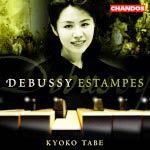
Estampes and other works for piano
 $40.00
Out of Stock
$40.00
Out of Stock6+ weeks add to cart
DEBUSSY
Estampes and other works for piano
Kyoko Tabe (piano)
[ Chandos Classics / CD ]
Release Date: Friday 1 June 2001
This item is currently out of stock. It may take 6 or more weeks to obtain from when you place your order as this is a specialist product.
'Kyoko Tabe's Debussy is far more sensual, though never excessively so… she seems to me closer to the Gieseking tradition.'
BBC Music Magazine
Some of Debussy's most popular piano works were originally written for piano students as alternatives to the staple diet of scales and Clementi studies.
Kyoko Tabe is building a successful catalogue of discs on Chandos. She has already released a solo disc of works by Sibelius and appeared as a soloist in works by Yoshimatsu, both to great critical acclaim.
The Deux Arabesques are early works dating from 1888-91 when Debussy was in his late twenties. One critic likened them to the ballet music of Delibes.
The Rêverie (1890) is another early piece. Debussy later dismissed it as 'bad', but its dreamy quality is enhanced by unusual harmonies and a shifting sense of key that heralded the more adventurous harmonic journeys he was still to take.
Estampes mark an enormous leap forward to the style of the mature Debussy. The title translates as 'prints' or 'engravings' and the pieces are a travelogue of national styles, from a glimpse of an exotic, oriental world to the nocturnal sights and sounds of Southern Spain before returning to Paris.
L'Isle joyeuse is based on a Watteau painting Debussy saw in the Louvre and it gave him the inspiration for one of his most rapturous and technically challenging piano works.
Children's Corner was dedicated to Debussy's daughter as an alternative to the staple diet of scales and Clementi studies available to budding pianists. Debussy's collection depicts, among other things, four of her favourite toys: Jumbo the elephant, a doll, a cardboard shepherd and a golliwog.
The Little Nigar, composed in 1909, is a sort of encore piece to Children's Corner, and is another of Debussy's contributions to elementary piano tuition, this time in the form of a cakewalk.
Meanwhile, it was a different sort of popular music which gave Debussy the idea for La Plus que lente in 1910. The 'valse lente', a sentimental slow waltz, was a popular and hackneyed genre of salon piece, so Debussy decided to outdo it with a 'more than slow' waltz. It is affectionately tongue-in-cheek
Tracks:
Rêverie
Estampes
Deux Arabesques
The Little Nigar
Children's Corner
La Plus que lente
L'Isle joyeuse
From 'Suite bergamasque'


